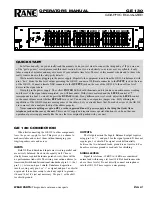
M 18-C … M 48-DC
Schaltungsbeschreibung / Circuit Desription
GRUNDIG Service
2 - 3
• Super class G - operation
The power amplifiers operate as so-called super class G - amplifi-
ers:
The supply pins 12 (Vcc) are not just connected to one fixed DC-
supply as in conventional amplifiers.
Dependent on the output power there are three different DC-
voltages supplied to the power amplifiers:
⇒
+C (+18V) for low output power
⇒
+B (+25V) for medium output power
⇒
+A (+36V) for high output power
Principle / benefit of Super Class G (Fig. 4 for M 28-C resp. Fig. 8
for M 48-DC)
• advantages:
- best efficiency
- less power drawn from the mains transformer than by conven-
tional operating amplifiers reduces transformer heating.
- reduced power dissipation at the amplifier ICs results in:
• less junction temperature and better reliability
• possibility of higher output power with smaller cooling fan
• smaller size
• Functional description of the super class G - circuitry used in the
amplifier-module
The DC-level on the amplifier output pins is normally Vcc/2.
With low sC is supplying the amplifiers via decoupling diode
6312. The DC-level on the output pins is therefore approx. 8,6V and
approx. 8V on the base of 7315.
When the output signal increases, also DC-level on base of 7315
increases via diodes 6305, 6306, 6307 and 6308. At a certain output
power 7315 becomes slightly conductive and enables low base
current for 7304 which becomes conductive too and pulls gate of
FET 7303 up to a more positive level. Thus FET 7303 begins to
switch through and connects the higher DC B1 slowly to the
power stages.
This does not end up in a hard switching but in a smooth regulating
because Vcc is coupled back to the emitter of 7315 via Zener diode
6310. As soon as Vcc increases also the level on emitter 7315 is
increased by a 3,9V lower level than Vcc. When the output power is
increased fB1 would not be high enough to enable
undistorted output signal. The more the output level increases the
more increases the DC-level on base of 7315 which causes the
transistor to become more and more conductive until the summary
of the voltage drop on 3340 + E/B 7304 + 3342 becomes approx.
1,4V. Now the necessary V
BE
for a darlington-type transistor is
obtained, 7305 begins to switch through and connects the again
higher DC A slowly to the power stages. 7305 regA,
same as described before for +B.
7322 and 7316 switch the ripple capacitor 2355, dependent on the
output power.
With low output power the DC-level on base 7322 is approx. 8V. Via
Zener diode 6310 and resistor 3333 the emitter is pulled to Vcc (+C
at low levels). 7322 is switched through and in turn 7316. The ripple
capacitor 2325 is connected to ground and functions as in normal
amplifiers. Hum is suppressed and good S/N-ratio is guaranteed
even during silent music passages.
When the supply voltage has to be switched to a higher level the DC-
level of the ripple capacitor has to increase in the same relation,
otherwise the reference voltages inside the IC would not fit to the
actual Vcc. Because of the different delays this relation cannot be
obtained and a continuously connected capacitor to the ripple input
would cause distortion. For that reason the ripple capacitor 2325 is
disconnected as soon as the output power exceeds a certain value.
When the output signal increases, also DC-level on base of 7322
increases via diodes 6305, 6306, 6307 and 6308. 7322 blocks and
in turn 7316. The ripple capacitor 2325 is disconnected from ground.
The circuitry is designed so that 2325 is disconnected just before
7303 begins to B through (see above).
• Super Class G - Betrieb
Die Leistungsverstärker arbeiten als sogenannte Super Class G -
Verstärker:
Im Gegensatz zu herkömmlichen Verstärkern sind die Spannungs-
eingänge Pins 12 (Vcc) nicht nur an einer einzigen festen Gleich-
spannung angeschlossen.
Je nach der Ausgangsleistung werden die Leistungsverstärker von
drei verschiedenen Gleichspannungen versorgt:
⇒
+C (+18V) für niedrige Ausgangsleistung
⇒
+B (+25V) für mittlere Ausgangsleistung
⇒
+A (+36V) für hohe Ausgangsleistung
Leistungsmerkmale / Vorteile des Super Class G (Fig. 4 für M 28-C
bzw. Fig. 8 für M 48-DC)
• Vorteile:
- höchste Leistungsfähigkeit
- geringere Erwärmung des Transformators, da der Verstärker
weniger Energie vom Netztransformator zieht als herkömmliche
Operationsverstärker
- der geringere Leistungsverbrauch an den Verstärker- ICs wirkt
sich wie folgt aus:
• geringere Sperrschichttemperatur und höhere Betriebssicher-
heit
• höhere Ausgangsleistung möglich mit kleinerem Kühlblech
• kleinere Maße
• Funktionsbeschreibung des Super Class G-Schaltkreises im Ver-
stärker
Im Normalfall beträgt der Gleichspannungspegel an den Ausgän-
gen des Verstärkers Vcc/2.
Bei niedrigem Signal liegt +C an den Verstärkern über die Aus-
kopplungsdiode 6312. An den Ausgängen steht somit eine Gleich-
spannung von ca. 8,6V und ca. 8V an der Basis von 7315.
Wird das Ausgangssignal höher, steigt auch der Gleichspannungs-
pegel an der Basis von 7315 über die Dioden 6305, 6306, 6307 und
6308. Bei einer bestimmten Ausgangsleistung schaltet 7315 etwas
durch, so daß ein geringer Basisstrom an 7304 fließt. Dieser wird
ebenso leitend und zieht das Gate des FET 7303 auf einen positi-
veren Pegel. Der FET 7303 beginnt durchzuschalten und versorgt
die Leistungsstufen langsam mit der höheren GleichspB1.
Dies hat zur Folge, daß die Spannung nicht abrupt einsetzt sondern
langsam hochgeregelt wird, da Vcc über die Zener-Diode 6310 an
den Emitter des 7315 rückgekoppelt wird. Mit steigender Vcc steigt
auch der Pegel am Emitter von 7315, und zwar um einen 3,9V
niedrigeren Pegel als Vcc. Steigt die Ausgangsleistung weiter, wäre
+B1 nicht hoch genug, um ein unverzerrtes Ausgangssignal zu
liefern. Je höher der Ausgangspegel, desto höher steigt der Gleich-
spannungspegel an der Basis von 7315, so daß der Transistor
immer mehr durchschaltet bis der gesamte Spannungsabfall an
3340 + E/B 7304 + 3342 ca. 1,4V beträgt. Jetzt steht die notwendige
U
BE
für einen Darlington-Transistor zur Verfügung, 7305 beginnt zu
leiten und schaltet die wiederum höhere GleichspA lang-
sam an die Leistungsstufen. 7305 übernimmt die Regelung der +A
entsprechend der obigen Beschreibung für +B.
7322 und 7316 schalten den Sieb-Kondensator 2355 in Abhängig-
keit von der Ausgangsleistung.
Bei niedriger Ausgangsleistung ist die Gleichspannung an der Basis
7322 ca. 8V. Über die Zener-Diode 6310 und den Widerstand 3333
wird der Emitter auf Vcc gezogen (+C bei niedrigen Pegeln). 7322
schaltet durch und somit auch 7316. Der Sieb-Kondensator 2325
liegt an Masse und funktioniert wie in normalen Verstärkern. Auch
bei leisen Musikpassagen wird ein Brummen unterdrückt und ein
guter Rauschabstand erzielt.
Soll auf eine höhere Versorgungsspannung geschaltet werden,
muß die Gleichspannung des Sieb-Kondensators im gleichen Ver-
hältnis steigen, ansonsten würden die Bezugsspannungen im IC
nicht mit der tatsächlichen Vcc übereinstimmen. Aufgrund der
verschiedenen Verzögerungen kann dieses Verhältnis nicht er-
reicht werden und ein ständig am Sieb-Eingang angeschlossener
Kondensator würde Störungen verursachen. Deshalb wird der Sieb-
Kondensator 2325 sofort getrennt, wenn die Ausgangsleistung
einen bestimmten Wert überschreitet. Mit steigendem Ausgangs-
signal steigt auch der Gleichspannungspegel an der Basis von 7322
über die Dioden 6305, 6306, 6307 und 6308. 7322 sperrt und somit
auch 7316. Der Sieb-Kondensator 2325 wird von Masse getrennt.
Die Schaltung ist so konzipiert, daß 2325 getrennt wird unmittelbar
bevor 7303 die +B durchzuschalten beginnt (siehe oben).
















































